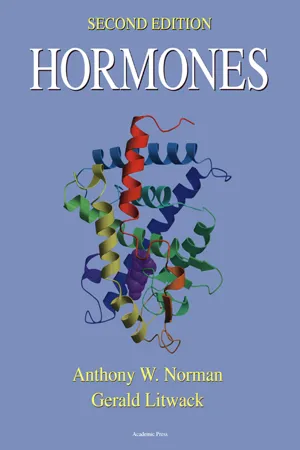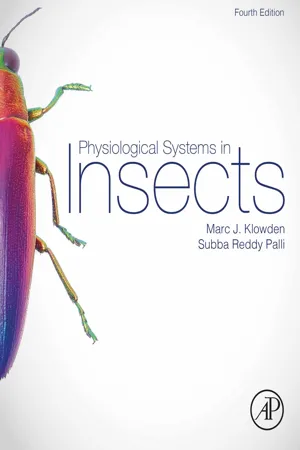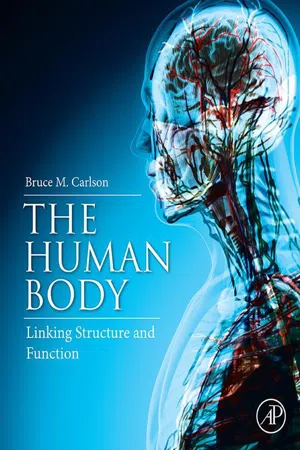Biological Sciences
Endocrine Signaling
Endocrine signaling is a form of cell communication in which specialized cells release hormones into the bloodstream to target distant cells. These hormones travel through the circulatory system and bind to specific receptors on target cells, triggering a response. This system plays a crucial role in regulating various physiological processes, including metabolism, growth, and reproduction.
Written by Perlego with AI-assistance
Related key terms
11 Key excerpts on "Endocrine Signaling"
- eBook - ePub
General and Comparative Endocrinology
An Integrative Approach
- A.M. Schreiber(Author)
- 2023(Publication Date)
- CRC Press(Publisher)
Despite the somewhat artificial distinctions among these three classes of signaling molecules, the endocrine, immune, and nervous systems communicate with each other to maintain organismal homeostasis. Together these three interacting chemical signaling classes have been referred to as bio-regulators. 3 As such, the scope of modern endocrinology has exploded from its origins as a specialty within the discipline of physiology that focused solely on endocrine glands and their internal secretions to a discipline addressing the entire spectrum of chemical communication in animals ranging from the molecular and cellular to the organismal and population levels. Some important differences between classical and modern endocrine thinking are summarized in Appendix 3. SUMMARY AND SYNTHESIS QUESTIONS Compare and contrast the classical and modern definitions of “hormone” and “endocrinology”. Fundamental Features of Endocrine Signaling LEARNING OBJECTIVE Describe the fundamental features of Endocrine Signaling. KEY CONCEPTS: • Whereas hormones are chemically diverse, ranging from modified amino acids to proteins, lipids, and other chemicals, all of their known receptors are proteins. • Hormones are active at extremely low concentrations and bind to specific receptors located at the surface and inside of target cells. • Many hormones bind to blood transport proteins, which increases their longevity and solubility in circulation. • One hormone can exert distinct effects on different cells and tissues by interacting with different receptors. • Intracellular signaling pathways transduce and amplify hormone signals. • Hormones mediate homeostasis via feedback control. • Hormones can exert “pleiotropic” effects. • In order to adapt to changing conditions, organisms must be able to change the homeostatic set points for a regulated parameter, a concept called “allostasis”. • Hormones are often secreted in rhythmic and pulsatile manners. • Hormones exist in a - eBook - ePub
- Anthony W. Norman, Gerald Litwack(Authors)
- 1997(Publication Date)
- Academic Press(Publisher)
As stated earlier, hormones are chemical messengers that send a signal within a physiological system from point A to point B. There are four identifiable hormonal communication systems; each has a different anatomical relationship between point A and point B.1 Systemic
The classic systemic endocrine system is described in Figure 1-1 . The hormone is biosynthesized and stored within specific cells associated with an anatomically defined endocrine gland. The hormone is not released until receipt of an appropriate physiological signal, which may take the form of either a change in the concentration of some component in the blood (e.g., [Ca2+ ], [glucose], [K+ ]) or the delivery of a neural signal. Once released into the bloodstream, the hormone can travel to a distant cellular target, frequently the hormone (particularly if it is a hydrophobic molecule like the steroid hormones) may be carried in the bloodstream by a specific transport protein [e.g., transcortin for Cortisol, the vitamin D-binding protein for 1,25(OH)2 D3 ]. The target cell for hormone X is by definition a cell that possesses specific high-affinity receptors for hormone X. Then, as a consequence of accumulation of the hormone by the target cell, a signal transduction process ensues and a specific set of biological responses is generated. Frequently some aspect of the biological responses will result in a change in the concentration of some blood component so that a “feedback” signal is sent to the originating endocrine gland to diminish the biosynthesis and secretion of the hormone. Thus, the endocrine B cell of the pancreas secretes insulin in response to elevated blood glucose levels. The glucagon then acts upon distal liver cells to decrease the blood levels of glucose, and the decreased blood glucose then feeds back upon the pancreatic B cell to diminish the secretion of the insulin.Classic endocrine systems involve secretory glands that release their hormone products into the open or general circulatory system (the B-cell/liver system described earlier), as well as closed circulatory systems. An example of the latter is the secretion of the hypothalamic releasing hormones into a closed portal system, which ensures that most of these hormones will be delivered to the anterior pituitary, which contains the target cells for these releasing hormones; see Figure 1-2 - eBook - ePub
- R. Michael Akers, D. Michael Denbow(Authors)
- 2013(Publication Date)
- Wiley-Blackwell(Publisher)
12 Endocrine systemContentsIntroduction and OverviewCell SignalingMechanisms of Cell Surface Hormone Signaling Mechanisms of Internal Hormone Cell Signaling Receptors and Regulation Measuring Circulating Hormone Concentrations Endocrine and Growth Factor SignalingThe Hypophyseal-Pituitary AxisPituitary Overview Negative Feedback Loops Hormones and Cells of the Posterior PituitaryHormones of the Anterior PituitarySomatotropin (GH) The Somatomedin Hypothesis GH Secretion Prolactin Prolactin Secretion Follicle-Stimulating Hormone and Luteinizing Hormone Thyroid-Stimulating Hormone Adrenocortropic HormoneThyroid GlandAdrenal Gland Endocrine Pancreas Other Hormones and Growth Factors IGF Family EGF Family FGF Family TGF-β Family Leptin Chapter SummaryBiosynthesis of Triiodothyronine and Thyroxine Biological Effects of Thyroid Hormones Calcitonin Parathyroid HormoneIntroduction and overview
As we consider regulation of homeostasis , two closely linked interacting physiological systems, the nervous and endocrine system, are critical. As a general rule, actions mediated by the nervous system are typically acute and relatively short-lived, whereas endocrine effects are often slow to develop but frequently generate responses that continue for hours or even weeks. Some simple examples illustrate these points. Consider what happens with overheating. As the core body temperature rises, warmer blood flowing to the hypothalamus and other brain areas initiates nerve impulses relayed by efferent spinal nerve tracts to the smooth muscle sphincters of the arterioles controlling blood flow to the dermis . This produces relaxation and thereby increased blood flow so that heat can be lost. Nerve fibers also stimulate the secretion - eBook - ePub
Boron & Boulpaep Concise Medical Physiology E-Book
Boron & Boulpaep Concise Medical Physiology E-Book
- Walter F. Boron, Emile L. Boulpaep(Authors)
- 2020(Publication Date)
- Elsevier(Publisher)
− 12 M) at which many hormones circulate.Once a hormone is recognized by its target tissue or tissues, it can exert its biological action by a process known as signal transduction (see Chapter 3 ). Some hormones elicit responses within seconds (e.g., the increased heart rate provoked by epinephrine or the stimulation of hepatic glycogen breakdown caused by glucagon), whereas others may require many hours or days (e.g., the changes in salt retention elicited by aldosterone or the increases in protein synthesis caused by growth hormone [GH]).Principles of Endocrine Function
Chemical signaling can occur through endocrine, paracrine, or autocrine pathways
As shown in Fig. 3.1A , in classic Endocrine Signaling, a hormone carries a signal from a secretory gland across a large distance to a target tissue. Hormones secreted into the extracellular space can also regulate nearby cells without ever passing through the systemic circulation. This regulation is referred to as paracrine action of a hormone (see Fig. 3.1B ). Finally, chemicals can also bind to receptors on or in the cell that is actually secreting the hormone and thus affect the function of the hormone-secreting cell itself. This action is referred to as autocrine regulation (see Fig. 3.1C ). At the outset, it can be appreciated that summation of the endocrine, paracrine, and autocrine actions of a hormone can provide the framework for a complex regulatory system.Endocrine Glands
The major hormones of the human body are produced by one of seven classic endocrine glands or gland pairs: the pituitary, the thyroid, the parathyroids, the testes, the ovaries, the adrenals (cortex and medulla), and the endocrine pancreas. In addition, other tissues that are not classically recognized as part of the endocrine system produce hormones. These tissues include the central nervous system (CNS), particularly the hypothalamus, as well as the gastrointestinal tract, adipose tissue, liver, heart, and kidney. - eBook - ePub
Essential Physiological Biochemistry
An Organ-Based Approach
- Stephen Reed(Author)
- 2013(Publication Date)
- Wiley(Publisher)
It would not be conducive to learning if a biochemistry lecture were to be held in the same lecture theatre at the same time as a presentation on, say, French literature of the seventeenth century. Multicellularity allows efficiency through metabolic and physiological specialization, but the disadvantage is ensuring coordinated activity; team work is vital for physiological success. Coordination of metabolic activity is achieved by an intricate system of communication where signalling molecules such as hormones (derived from the Greek for ‘ arouse to activity ’ and sometimes called the ‘first messengers’), growth factors, cytokines, and neurotransmitters are released by one cell and target (i) a distant cell (classic hormones), (ii) a neighbouring cell (local hormones and neurotransmitters) or (iii) the same cell (autocrine hormones), and initiate an appropriate metabolic and physiological response in that target. The word ligand describes a small molecule which binds to a larger molecule and in the context of cellular communication means the primary signal (hormone, neurotransmitter, growth factor, etc.). Cell signalling and signal transduction are topics of great research interest, partly because defects of these processes are associated with diseases such as type 2 diabetes, cancer and obesity. In recognition of this is the fact that a number of Nobel Prizes for Medicine or Chemistry have been awarded to researchers of cell communication. This chapter describes the nature of the disparate signalling molecules and how they regulate the activity of their targets. 4.2 Physiological aspects 4.2.1 The classical endocrine system The classical endocrine system is composed of a series of glands that secrete hormones directly into the blood where they are carried to act on cells in the body often quite distant from the place of secretion. Insulin, for example, secreted from β pancreatic islet cells has actions on fuel metabolism in most tissues of the body - eBook - ePub
- Richard I. G. Holt, Neil A. Hanley(Authors)
- 2021(Publication Date)
- Wiley-Blackwell(Publisher)
Part 1 Foundations of Endocrinology CHAPTER 1 Overview of endocrinology Key topics A brief history of endocrinology and diabetes The role of hormones Classification of hormones Control systems regulating hormone production Endocrine disorders Key points Learning objectives To be capable of defining endocrinology To understand what endocrinology means as a basic science and a clinical specialty To appreciate the history of endocrinology To understand the classification of hormones into peptides, steroids and amino acid derivatives To understand the principle of how feedback mechanisms regulate hormone levels in the circulation This chapter introduces endocrinology and diabetes including some of the basic principles that underpin the following chapters Box 1.1 The endocrine and nervous systems are the two main communication systems in the body Monitor internal and external environments Ensure homeostasis Allow appropriate adaptive changes Communicate via chemical messengers Figure 1.1 Chemical signalling in the endocrine and neural systems. (a) In endocrine communication, the producing cell secretes hormone into the blood vessel, where it is carried, potentially over large distances, to its target cell. (b) Sometimes hormones can act on the cell that produces them (autocrine, A) or nearby cells (paracrine, P) without the need for transport via the circulation. For instance, glucagon from α‐cells and somatostatin from δ‐cells can regulate insulin secretion by adjacent β‐cells within the pancreatic islet. (c) In neuroendocrine communication, neurons can secrete hormones into the surrounding blood vessels to reach a more distant target. A good example is hypothalamic regulation of the anterior pituitary. (d) In pure neural communication, neurons activate other neurons via neurotransmitters released from axonic terminals into the synaptic space - eBook - ePub
- Marc J. Klowden, Subba Reddy Palli(Authors)
- 2022(Publication Date)
- Academic Press(Publisher)
Fig. 1.3D ). Only those cells with receptors that recognize a given hormone are capable of responding. The signaling cells may consist of endocrine cells or more specialized neurosecretory cells. Some Endocrine Signaling molecules are hydrophobic and are able to cross the cell membrane and bind to internal receptor proteins, while most others are peptides that must remain outside and bind to external receptors.Paracrine signaling is a bit more intimate, with the signal molecules diffusing not through the blood but instead through the extracellular matrix (Fig. 1.3E ). The proteins secreted by the target cells are effective over only a short distance and induce changes only in neighboring cells that bear specific receptors localized in regions of cytoplasmic extensions called cytonemes. Because many of the signal molecules involved are proteins that are unable to enter cells through the plasma membrane, pathways of signal transduction operate within the target cells for their activation, with an extracellular receptor communicating the signal to the cell interior.The remainder of this chapter is devoted to several important paracrine and endocrine systems in insects.Paracrine signaling
There is remarkable conservation of protein messengers used for many diverse processes throughout the animal kingdom. Very similar factors operate in both mammals and insects, and with even more beautiful parsimony are used at different times for different developmental events within the same organism. These are the morphogens that diffuse short distances over fields of cells and regulate gene transcription. They have been grouped into four protein families on the basis of their structural similarities.Fibroblast growth factors (FGF) are important during embryonic development, tissue construction, and regeneration after wounding. An example is the Breathless FGF protein that activates the Branchless FGF receptor (FGFR) protein to regulate terminal branching in the developing tracheal system of Drosophila. An FGF protein binds to an FGFR and activates a kinase that phosphorylates proteins within the responding cell. One transduction cascade initiated by FGFs is the receptor tyrosine kinase (RTK) transduction pathway, where a specific paracrine factor ligand binds to the extracellular portion of the receptor and induces a conformational change that activates the kinase activity of the cytoplasmic portion and autophosphorylates key tyrosine residues (Fig. 1.4 ). This then recruits proteins functioning as adaptors that couple the receptor to other proteins that can activate still other proteins to pass the message along. One of these important proteins is Ras - eBook - ePub
- Marc J. Klowden(Author)
- 2013(Publication Date)
- Academic Press(Publisher)
Figure 1.8 ).Figure 1.8 Ligands in the TGF-β superfamily bind to and activate serine-threonine kinase type I and II receptors. The activated receptor phosphorylates Smad proteins that then recruit a co-Smad. The complex enters the nucleus as a transcription factor.Endocrine Signaling
Hormones are the chemical messengers of multicellular organisms that allow the cells to communicate to more distant and widespread targets and engage in coordinated responses. They are especially pervasive in insect systems, affecting a wide variety of physiological processes, including embryogenesis, postembryonic development, behavior, water balance, metabolism, caste determination, polymorphism, mating, reproduction, and diapause. Hormones work along with the nervous system to provide the necessary communications between the many distant cells that comprise a multicellular animal. As in other signaling systems, tissues process the message only if they have the proper receptors that enable them to recognize it. Hormones therefore allow a sustained message to be sent to all cells, but only those cells that posses the receptors are capable of responding.The method by which insect epidermal cells communicate during molting is a good example of the difference between nervous and Endocrine Signaling. The molting process, regulated by several hormones, requires hours for its full completion in many insects. It could occur faster if it were coordinated by the nervous system, but that would mean that all the epidermal cells involved would have to receive a nervous message, thereby hopelessly complicating the internal environment with neurons and leaving little room in the body for other organs. There are some cells that may not participate in molting; these are oblivious to the hormonal conditions because they lack receptors. Other processes, such as feeding and escape, cannot rely on the slowness of the endocrine system and are regulated by the nervous system. If information regarding some threat in the environment, such as a predator, were to be relayed by the endocrine system in order to initiate escape behavior, the insect would probably be eaten well before the message arrived. By selecting hormones as a messenger for some systems, insects have made a trade-off between the speed of the response and the complexity of the system that would be required for its implementation. - eBook - ePub
The Human Body
Linking Structure and Function
- Bruce M. Carlson, Bruce M. Carlson(Authors)
- 2018(Publication Date)
- Academic Press(Publisher)
The endocrine system is often compared with the nervous system, both of which touch almost all components of the body, but aside from their wide distribution, their differences outweigh their similarities. Through its network of nerve fibers, the sensory component of the nervous system collects specific information from almost all areas of the body, but on the effector side, the direct action of the nervous system is limited to skeletal muscle fibers (through the motor endplates), smooth and cardiac muscle, and glandular tissue. Endocrine glands, on the other hand, respond to signals carried to them by the blood, lymph, or nerve fibers, but their hormonal secretions are carried to cells throughout the body. Although almost all cells of the body are exposed to circulating hormones, only if they have appropriate receptors to specific hormones will they respond. Whereas signaling by the nervous system is measured in ms, hormonal effects can take from seconds to even days to be felt.Classical endocrinology was focused on the grossly identifiable endocrine glands (Fig. 9.1 ), but researchers have increasingly recognized that many cells and tissues secrete powerful hormones that affect both nearby and distant cells. Hormonal effects are described as endocrine (working at a distance and carried mainly through the blood), paracrine (diffusion in tissue fluids to nearby cells and tissues), or autocrine (affecting the cells that actually produced the hormones) (Fig. 9.2 ). Characteristic of all endocrine glands (in contrast to exocrine glands) is the absence of a duct system for removal of the hormonal secretions from the gland. Instead, endocrine glands are endowed with an abundant microcirculation that surrounds the hormone-producing cells (Fig. 9.3 ). The secreted hormonal products are quickly and efficiently taken up by the local capillaries and from there are carried by the blood to all parts of the body.Figure 9.1 Locations of major endocrine glands throughout the body. From Guyton and Hall (2006), with permission.Figure 9.2 Types of chemical messaging among cells. From Stevens and Lowe (2005), with permission.Figure 9.3 Scanning electron micrograph of dense capillary networks surrounding follicles in the thyroid gland. From Erlandsen and Magney (1992), with permission.Figure 9.4 Steps in the uptake of a steroid hormone by a cell and the cell’s response. After diffusion through the plasma membrane, the hormone could either bind to a cytoplasmic receptor and make its way into the nucleus or directly enter the nucleus and bind to a nuclear receptor. After it interacts with a specific region of DNA, the DNA then produces an appropriate mRNA, and synthesis of a new protein is initiated. From Guyton and Hall (2006), with permission.Figure 9.5 A typical interaction of a cell with a protein hormone. The hormone binds to a transmembrane receptor. This releases a molecular cascade that ultimately produces a cellular response. ADP , Adenosine diphosphate; cAMP , cyclic adenosine monophosphate; GTP , guanosine triphosphate. From Guyton and Hall (2006), with permission. - Nicoladie Tam(Author)
- 0(Publication Date)
- Nicoladie Tam, Ph.D.(Publisher)
para = parallel, next; -crine = secreting) system was evolved next when the organism evolved to be larger multicellular organism. Communication with the neighboring cells becomes more important for multicellular organisms.Paracrine system relies on diffusion to spread the chemical signal. What is an endocrine system? It is the system, which releases chemicals to the inside of the body.Hormones are usually released in the endocrine system. Endocrine (endo = inside; -crine = secreting) system includes glands that secrete chemicals inside the body.When an organism evolved even bigger that contain billions of cells, communication via diffusion by the paracrine system is inefficient. Instead, endocrine system is evolved to take advantage of the circulatory system to move the chemical signal (hormone) by a pump.What is an exocrine system? It is the system, which releases chemicals to the outside of the body.Sweat and tears are examples of the exocrine system. Exocrine (exo = outside; -crine = secreting) system includes glands that secrete chemicals to the body surface.What is the progression in the evolution of endocrine system? It evolves from autocrine system to paracrine system to endocrine system.This progress is a consequence of the increase in size of the animal. As the size increase, diffusion of chemical is too inefficient and too slow. As a result, forced convection (pumping) of the chemical signal via the circulatory system provides a faster delivery of the signal.What is the difference between communication using chemical signals versus electrical signals?Chemical signals are transmitted a lot slower than electrical signal. Physical delivery of signal occurs in chemical signal whereas wave propagation is used to deliver electrical signal, which is faster.Communication using chemical signals is still too slow for most vital survival activities. That is because it relies on the physical delivery of the signal from point A to point B, i.e., from secretory cell to target cell.- eBook - ePub
Lecture Notes
Human Physiology
- Ole H. Petersen, Ole H. Petersen(Authors)
- 2019(Publication Date)
- Wiley-Blackwell(Publisher)
Cells communicate with one another by chemical signals that either diffuse between cells (neurotransmitters, and paracrine and autocrine agents), or are disseminated in the blood (hormones). These signals include small organic molecules (e.g. acetylcholine and adrenaline), and larger molecules such as proteins and steroids. Cells may also communicate with their immediate neighbours through gap junctions, which transmit both electrical and chemical signals.Chemical signalling
The nervous and endocrine systems use chemical signals, neurotransmitters and hormones, respectively, for communication. Neurotransmitters are released from neurones, diffuse across a narrow synaptic space or cleft (<100 nm) and act on adjacent neurones, muscle cells or secretory cells in glands; hormones are transmitted in the circulation and act on cells of distant target organs. Hormones act at very low concentrations, typically 10−6 to 10−9 mol L−1 (but in some cases as low as 10−12 mol L−1 ), while the concentrations of neurotransmitters in synaptic clefts may reach 5 × 10−4 mol L−1 (e.g. acetylcholine at the neuromuscular junction). In addition there are paracrine agents released locally by cells that act on neighbouring cells and autocrine agents that act on the cells that produced them. Therefore neurotransmitters, by definition, are paracrine agents, although they are not usually classified as such, and some hormones, e.g. gastrointestinal hormones, may also be classified as paracrine agents, because they may act locally as well as travelling in the blood stream to distant target organs. Secretions of neurones that are transported to distant target organs in the blood stream are referred to as neurohormones. Finally, certain cells secrete growth factors that are essential at critical stages in the development of their target cells.Chemical signals may be ions or metabolites (e.g. Ca2+ , glucose or amino acids) which stimulate certain endocrine cells; they may be simple organic molecules (e.g. the neurotransmitters acetylcholine, noradrenaline and glutamate), or they may be more complex molecules (e.g. protein and steroid hormones). Even dissolved gases such as nitric oxide and carbon monoxide may act as chemical signals between cells. Many substances that were first identified as hormones produced in endocrine glands are also synthesized in the nervous system where they act as neurotransmitters or neuromodulators (see Chapter 3
Index pages curate the most relevant extracts from our library of academic textbooks. They’ve been created using an in-house natural language model (NLM), each adding context and meaning to key research topics.










